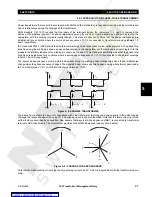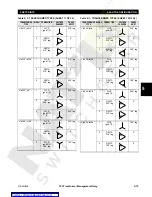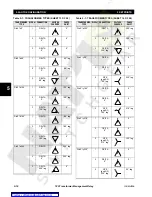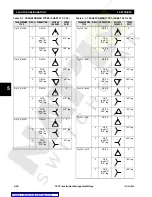
GE Multilin
745 Transformer Management Relay
5-9
5 SETPOINTS
5.2 AUTO-CONFIGURATION
5
The 745 performs this phase angle correction internally based on the following setpoint. Set
S2 SYSTEM SETUP
Ö
TRANS-
FORMER
ÖØ
TRANSFORMER TYPE
to “Y/d30°”.
The 745 supports over 100 two and three-winding transformer types. Table 5–1: Transformer Types on page 5–10 provides
the following information about each transformer type:
As shown in the “Y/d30°” entry of the table of transformer types, the phase angle correction (or phase shift) introduces 30°
lag in Winding 1. This lag is described in Table 5–2: Phase Shifts on page 5–22. This table provides the following informa-
tion about each phase shift type:
5.2.5 ZERO-SEQUENCE COMPONENT REMOVAL
1.
If zero-sequence current can flow into and out of one transformer winding (e.g. a grounded Wye or zig-zag winding)
but not the other winding (e.g. a Delta winding), external ground faults will cause the differential element to operate
incorrectly. Traditionally, this problem is solved by Delta connecting the CTs on the Wye side of a Wye/Delta trans-
former so that the currents coming to the relay are both phase corrected and void of zero-sequence current. Because
the 745 software mimics the CT Delta connection, the zero-sequence current is automatically removed from all Wye or
zig-zag winding currents of transformers having at least one delta winding.
2.
External ground faults also cause maloperation of the differential element for transformers having an in-zone ground-
ing bank on the Delta side (and the Wye connected CTs on the same side). Traditionally, this problem is solved by
inserting a zero-sequence current trap in the CT circuitry. The 745 automatically removes zero-sequence current from
all Delta winding currents when calculating differential current. Where there is no source of zero-sequence current (e.g.
Delta windings not having a grounding bank), the 745 effectively removes nothing.
3.
Autotransformers have an internal tertiary winding to provide a path for third-harmonic currents and control transient
overvoltages. Also, many two-winding Wye/Wye transformers have a three-legged core construction that forces zero-
sequence flux into the transformer tank, creating an inherent Delta circuit. In both these cases, there is zero-sequence
impedance between the primary and secondary windings. The 745 removes zero-sequence current from all Wye/Wye
and Wye/Wye/Wye transformer windings to prevent possible relay maloperations resulting from these two conditions.
TRANSFORMER
TYPE
WDG
#
CONNECTION
VOLTAGE
PHASORS
PHASE
SHIFT
Y/d30°
1
WYE
(gnd 1/2)
30° lag
2
DELTA
30° lag
0°
angle by which a winding lags Winding 1
winding connection (wye, delta, or zig-zag) and ground CT assignment
transformer type notation as it appears on the display
diagrams showing the phase rela-
tionship of voltage phasors, where
↑
(the arrow head) indicates the
reference phase
phase angle correction (or phase shift)
that is performed internally to calculate
differential currents
PHASE
SHIFT
INPUT
PHASORS
OUTPUT
PHASORS
PHASOR
TRANSFORMATION
30° lag
a = (A – C) /
b = (B – A) /
c = (C – B) /
3
3
3
the phasors after the phase shift is applies (a/b/c)
the phasors before the phase shift is applied (A/B/C)
the phase shift as it appears in the table of transformer types
the equations used to achieve the
phase shift (A/B/C
→
a/b/c)
Содержание TRANSFORMER MANAGEMENT RELAY 745
Страница 2: ...Courtesy of NationalSwitchgear com ...
















































